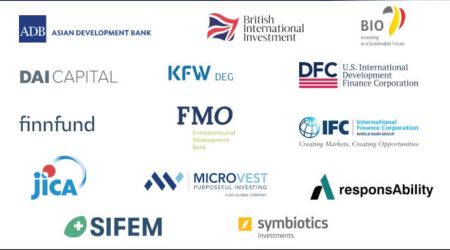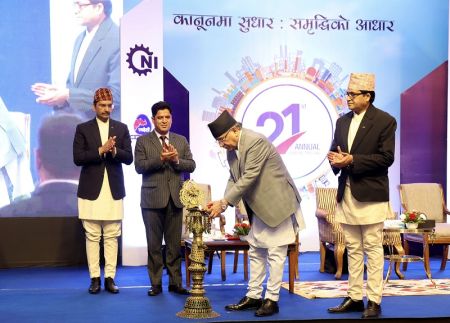.jpg)
--By Dr Rabindra Karna
.jpg)
Mergers and acquisitions (M&A) are widely appreciated by business communities as significant and strategic growth opportunities. In recent years, the financial services industry in Nepal has also seen some mergers and acquisitions. Some examples of mergers in Nepal include Laxmi Bank and former finance company HISEF which merged in 2004; finance companies National Finance and Narayani Finance which merged in 2009 to form the National Narayani Finance; and the Pokhara-based Shangri-la Development Bank and the Nepalgunj-based Bageshwori Development Bank which merged in 2010.
Mergers and acquisitions seek to offer a great variety of products, securing economic goal and lengthening geographic reach. However, it is not an easy task to achieve a healthy business growth through M&A, particularly, in the financial services industry. Smooth, effective and efficient amalgamation of the companies becomes important which helps in channeling skills, boosting the morale of employees and absorbing the intellectual asset of both organizations.
In the course of mergers and acquisitions, most business houses focus on tangible assets such as financial structures, IT systems or intellectual property; whereas most cases of conflict experienced mainly arise from ignorance about shared vision, leadership clashes, cultural mismatch, procrastination, neglected management and poor communication.
In many instances, cultural clashes and ignoring people’s expectations compromise the integration of two companies. This results in poor planning and immature management process and herein stops all effort to have a new entity on the verge of gaining market shares. Most unsuccessful mergers and acquisitions fail to meet expectations (expected business destination) not only in strategic fitness but also in people-related matters.
.jpg) Mergers and acquisitions grant massive talent for business advancement that cannot be reached through natural increment. Because people are important to lead and drive change, it is crucial to pay close attention to the human aspect of business as it has great influence on the path of success for merger and acquisitions.
Mergers and acquisitions grant massive talent for business advancement that cannot be reached through natural increment. Because people are important to lead and drive change, it is crucial to pay close attention to the human aspect of business as it has great influence on the path of success for merger and acquisitions. Herein begins the need for companies to assess the function and capability of human resource practitioners – to look at whether they hold the desired skills and motivation to lead a strategic role in the changed management process, or not. In most cases, the HR function, in our business perspective, is traditional and limited to personnel administration. In such cases, the HR leadership is unlikely to bring forth a strategic partnership in the team. But whatever be the situation, the HR leadership along with its team, must be prepared for the execution of ‘Change Management Plan’ to ensure success of M&A. For this, the top leadership team heading the merger or acquisition must clarify expectations from the HR department in terms of talent retention, communication, cultural integration and other factors that come to play.
In the event of a merger or acquisition, capability is considered an issue in HR leadership or team. The organisation will need to make serious efforts toward its HR transformation, turning the department into a strategic player. This may entail divesting HR of its more routine chores such as benefits enrollment and basic administrative tasks. This would allow the HR team to focus on providing high-level counseling to senior or top management such as for strategic staffing, long-term incentive plans and schemes for developing a team of the desired level.
.jpg)
To meet these obligations, HR practitioners must understand business functioning, its goals, financial operations, service development, marketing the product, and also the competitive landscape that makes them strategic business partners within the organization.
Management scientists unanimously agree that success in M&A depends on aligning the people, organizational and cultural assets of a company. Once the deal is secured, it is important to handle the outcome effectively. After merging or acquiring, financial service executives start focusing on the financial aspect due to risk assessments and relationships with investors. They give utmost care to the ways in which the new entity wants to create the shareholder’s value. But certain hurdles to success such as workforce management and cultural integration may pose themselves to the HR department. Providing solutions to these issues is a difficult task and HR readiness would be required in advance to assure the smooth transitioning post merging and acquiring.
Human resource professionals are required to have excellent communication strategies to understand and execute the integration, key talent retention and the organization’s restructuring and staffing. Integrating two organizations requires a comprehensive plan - a stage which in general, takes place within the first 100 days of the decision to merge. The role of the HR department in this phase would also include helping employees with the change.
Here, the HR supports the people and organisation through additional activities which include organization restructuring, talent retention and acquisition, communication, cultural integration, and reward and recognition. This can also include the integration of employment terms, payroll, in-employment and post-retirement benefits plans, and the development of new arrangements based on best practice from both legacies as well as best practices found externally. The HR department thus acts as a business partner when it comes to mergers and acquisitions.
.jpg) While success in merging financial services industries depends on offering a wider range of products and services within customers’ arm’s reach, smooth and effective integration is key to sustaining customers’ confidence. This entails channeling the skills and enthusiasm of employees, merging the intellectual capital of both organizations and streamlining the way in which the new business operates to rapidly overcome hurdles and take advantage of synergies and reduce unit cost. Success in mergers and acquisition hugely depends on aligning the people, organizational and cultural assets of the new entity, all of which largely come under the department of human resource.
While success in merging financial services industries depends on offering a wider range of products and services within customers’ arm’s reach, smooth and effective integration is key to sustaining customers’ confidence. This entails channeling the skills and enthusiasm of employees, merging the intellectual capital of both organizations and streamlining the way in which the new business operates to rapidly overcome hurdles and take advantage of synergies and reduce unit cost. Success in mergers and acquisition hugely depends on aligning the people, organizational and cultural assets of the new entity, all of which largely come under the department of human resource.




















